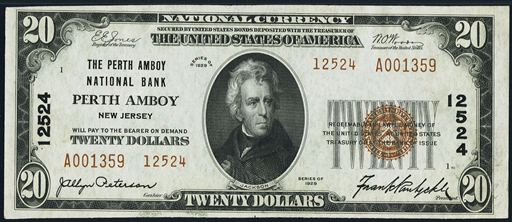The Streator National Bank Of Streator
The Streator National Bank Of Streator in Illinois printed $463,530 dollars worth of national currency. That is a pretty standard output. However, some types of currency from this bank could still be rare. This national bank opened in 1882 and stopped printing money in 1935, which equals a 54 year printing period. That is considering a long operation period for a national bank. During its life, The Streator National Bank Of Streator issued 14 different types and denominations of national currency. We have examples of the types listed below. Your bank note should look similar. Just the bank name will be different. For the record, The Streator National Bank Of Streator was located in LaSalle County. It was assigned charter number 2681.
We buy all national currency. Please call or email us for a quote. Sales@AntiqueMoney.com
The Streator National Bank Of Streator in Illinois issued 1,820 sheets of $10 series of 1875 national bank notes. Any time you see a print range between 1,000 and 2,500 you can assume that the bank was small and that their notes could be fairly scarce. The two vignettes seen on 1875 $10 bank notes are “Franklin and Electricity” and “America Seizing Lightning”. These notes occasionally confuse novices because the year 1752 is printed on them. That is when Benjamin Franklin discovered electricity. It has nothing to do with when these bank notes were issued. The back of each $10 bill has “DeSoto Discovering the Mississippi.”
Series of 1875 $10 National Bank Note
The Streator National Bank Of Streator printed 1,820 sheets of $20 series of 1875 national bank notes. The exact number of series of 1875 $20 national bank notes printed by this bank is good to know. Don’t expect a high number to lower the value or a small number to increase the value. These notes are scarce enough on their own that the stats don’t really matter. Twenty dollars was a lot of money between 1875 and 1901, which is the time period in which these were printed. These just weren’t saved in high numbers.
Series of 1875 $20 National Bank Note
The Streator National Bank Of Streator also printed 115 sheets of $50 series of 1875 national bank notes. The printing number for original series $50 bills is irrelevant. There are only about 35 known to exist from all banks in the country. To make matters worse, these are not being discovered much at all these days. The supply is pretty constant, as is the demand. Prices start at about $10,000 and can go up sharply from there.
Series of 1875 $50 National Bank Note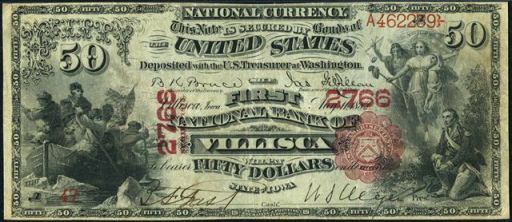
The Streator National Bank Of Streator also printed 115 sheets of $100 series of 1875 national bank notes. There are currently only about 70 series of 1875 $100 national bank notes known to exist. So the sheet output is really only included for factual purposes – it won’t affect values. The actual value is based on condition and bank of issue. If you don’t know how to grade currency, then send us pictures of what you have. We can help you grade and value any national bank note. Of course series of 1875 $100 bank notes would be a treat to see.
Series of 1875 $100 National Bank Note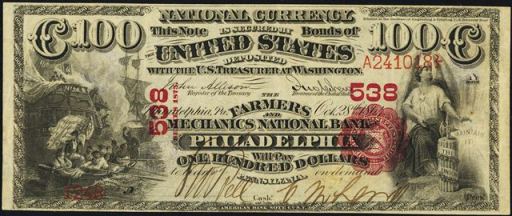
The Streator National Bank Of Streator also printed 1,400 sheets of $10 1902 red seal national bank notes. A print range between 1,000 and 2,500 is pretty standard for red seals. Despite being standard, in the scheme of things that is still an extremely small quantity printed. Collectors love ten dollar 1902 red seals. They usually represent the rarest bank notes printed by any national bank. Don’t let the term “series of 1902” confuse you. These were actually printed for about six years between 1902 and 1908. That is obviously a very short issue period which means that many red seals are quite rare. Each note has a portrait of William McKinley. Be sure to check the number under McKinley. If it is #1 then you are dealing with a note from the first sheet of bank notes issued. Number one bank notes are worth even more money than the already rare red seals.
1902 $10 Red Seal National Bank Note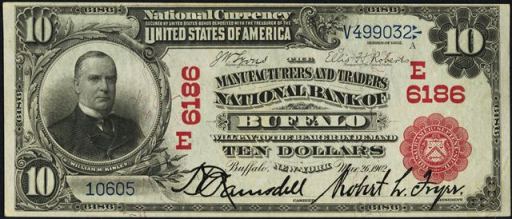
The Streator National Bank Of Streator also printed 1,400 sheets of $20 1902 red seal national bank notes. Twenty dollar red seal bank notes have poor survival rates. They don’t command premiums compared to the ten dollar denomination, but they are definitely rarer. All 1902 red seals were printed on four note sheets. There were three ten dollar bills and one twenty dollar bill per sheet. The 1902 $20 notes have a portrait of Hugh McCulloch on them. The charter number and seal are both printed in red ink. The serial numbers have a slight blue tint to them. The charter number is printed around the border of the note several times. The bank’s title is right in the middle of the note and the state of issue is printed just below the title. Remember that all national bank notes are valued based on their condition and rarity. The same rule applies to 1902 $20 red seals.
1902 $20 Red Seal National Bank Note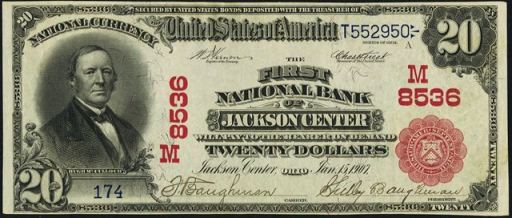
The Streator National Bank Of Streator also printed 2,673 sheets of $10 1902 blue seal national bank notes. Many small national banks could be in business for years and only print between 2,500 and 5,000 sheets of blue seals. 1902 $10 blue seal bank notes all have a portrait of William McKinley on them. Values can range from as little as $40 up to over $10,000. There really is no trick to know what is rare and what is common by just doing an internet search. You really need to work with an expert (like us) in order to determine the value of your specific bank note. There are at least ten different factors than can make some 1902 $10 blue seals worth more than others. We know exactly what to look for and we would be happy to provide a free appraisal and our best offer.
1902 $10 Blue Seal National Bank Note
The Streator National Bank Of Streator also printed 2,673 sheets of $20 1902 blue seal national bank notes. The same rarity rules for 1902 $10 blue seals also apply to $20 blue seals. Just remember that $20 bills are by nature three times rarer (unfortunately they don’t command a premium over other denominations). Hugh McCulloch is pictured on the front of each bill. Contact us if you need pricing help.
1902 $20 Blue Seal National Bank Note
The Streator National Bank Of Streator also printed 1,897 sheets of $10 1902 blue seal national bank notes. Most banks that printed such a small number of blue seal bank notes fall into the rare bank category. 1902 $10 blue seal bank notes all have a portrait of William McKinley on them. Values can range from as little as $40 up to over $10,000. There really is no trick to know what is rare and what is common by just doing an internet search. You really need to work with an expert (like us) in order to determine the value of your specific bank note. There are at least ten different factors than can make some 1902 $10 blue seals worth more than others. We know exactly what to look for and we would be happy to provide a free appraisal and our best offer.
1902 $10 Blue Seal National Bank Note
The Streator National Bank Of Streator also printed 1,897 sheets of $20 1902 blue seal national bank notes. The same rarity rules for 1902 $10 blue seals also apply to $20 blue seals. Just remember that $20 bills are by nature three times rarer (unfortunately they don’t command a premium over other denominations). Hugh McCulloch is pictured on the front of each bill. Contact us if you need pricing help.
1902 $20 Blue Seal National Bank Note
The Streator National Bank Of Streator also printed 530 sheets of Type1 1929 $10 national bank notes. This is a small print range, but it does not guarantee rarity. Each $10 bill from 1929 has a portrait of Alexander Hamilton on it. The black number written vertically is the charter number. The charter number never affects the value; it is just an identifier. The ten dollar type1 national bank note happens to be the single most common national bank note, with over 65,000 known to exist from all banks. Of course each note is valued based on its condition and rarity. Some are very rare.
Series of 1929 Type1 $10 National Bank Note
The Streator National Bank Of Streator also printed 138 sheets of Type1 1929 $20 national bank notes. That is an extremely small sheet printing number. Survivors are still likely but definitely not guaranteed. Andrew Jackson is featured on the front of each 1929 $20 bill. Be sure to take note of the serial number on your specific bank note. If it is 000001 then you can expect a nice premium. There is a special market for serial number one bank notes. Of course, even if the number isn’t #1, it could still be collectible and have a high value just based on its condition and rarity alone.
Series of 1929 Type1 $20 National Bank Note
The Streator National Bank Of Streator also printed 604 individual notes from the type2 1929 $10 national bank note series. Type2 1929 national bank notes are already rare to begin with. A printing of less than 1,000 is especially low. The easiest way to spot the difference between type1 1929 $10 bills and 1929 type2 $10 bills is in the serial number. Type2 notes have a serial number that ends with a number. 1929 type1 notes have a serial number that ends with the letter A. Generally speaking, these $10 bills are rarer than the earlier type1 issues. However, most collectors don’t pay more for that rarity because they look basically the same.
Series of 1929 Type2 $10 National Bank Note
The Streator National Bank Of Streator also printed 119 individual notes from the type2 1929 $20 national bank note series. Type2 1929 national bank notes are already rare to begin with. A printing of less than 1,000 is especially low. One of the great things about 1929 type2 $20 national bank notes is that they really aren’t that old and some can be extremely rare. Until the big head $20 series started there really wasn’t much difference between something printed in 1929 and the same bill printed in 1993. We have bought some examples in the past few months that people just found in their change.
Series of 1929 Type2 $20 National Bank Note